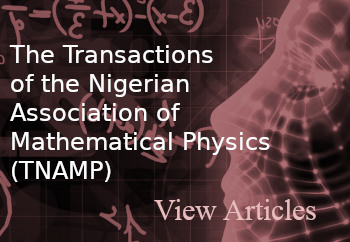KINEMATIC WAVE SPEED OF FLOW-DENSITY MODELS OF VEHICULAR TRAFFIC FLOW
DOI:
https://doi.org/10.60787/jnamp-v67i1-342Keywords:
Kinematic wave model, Fundamental diagram, Kinematic wave speed, Flow-density model, Shock waveAbstract
Kinematic wave speed represents the propagation of information within traffic states. How well equilibrium functional form of an empirical fundamental diagram predicts this parameter determines how well a kinematic wave model replicates observed traffic phenomena during simulation. In the light of this, we investigated the kinematic wave speed prediction of some selected functional forms of an empirical fundamental diagram. GA400 data was used to calibrate the models and access their fitting accuracy. The first derivatives of the selected models were plotted against density, and the predicted jam density for each model was substituted into its derivative to determine its kinematic wave speed at jam. The results show that the newly proposed model [14] produces the most likely kinematic wave speed observe on GA400 highway followed the model [2 and 17] respectively. These result shows that the proposed model could be more suitable for dynamic analysis using kinematic wave model.
Downloads
References
. B.D. Greenshields, “A study of traffic capacity,” Proc Highw. Res Board, vol. 14, pp. 448–477, 1935.
. Q. Cheng, Z. Liu, Y. Lin, and X. (Simon) Zhou, “An s-shaped three-parameter (S3) traffic stream model with consistent car following relationship,” Transp. Res. Part B Methodol., vol. 153, pp. 246–271, Nov. 2021, doi: 10.1016/j.trb.2021.09.004.
. D. Ni, “Field Theory for Some Traffic Phenomena and Fundamental Diagram,” Transp. Res. Rec. J. Transp. Res. Board, vol. 2675, no. 9, pp. 1195–1208, Sep. 2021, doi: 10.1177/03611981211006422.
. X. Qu, S. Wang, and J. Zhang, “On the fundamental diagram for freeway traffic: A novel calibration approach for single-regime models,” Transp. Res. Part B Methodol., vol. 73, pp. 91–102, Mar. 2015, doi: 10.1016/j.trb.2015.01.001.
. M. J. Cassidy, “Bivariate relations in nearly stationary highway traffic,” Transp. Res. Part B Methodol., vol. 32, no. 1, pp. 49–59, 1998, doi: 10.1016/S0191-2615(97)00012-X.
. J. M. Del Castillo and F. G. Benitez, “On the functional form of the speed-density relationship—I: General theory,” Transp. Res. Part B Methodol., vol. 29B, no. 5, pp. 373–389, Oct. 1995, doi: 10.1016/0191-2615(95)00008-2.
. J. S. Drake, J. L. Schofer, and A. D. May, “A Statistieal Analysis of Speed Density Hypotheses,” Veh. Traffic Sci., vol. 154, pp. 112–117, 1967.
. L. C. Edie, “Car-Following and Steady-State Theory for Noncongested Traffic,” Oper. Res., vol. 9, no. 1, pp. 66–76, 1961.
. H. M. Zhang, “Amathematical theory of traffic hysteresis,” Transp. Res. Part B, vol. 33, pp. 1–23, 1999.
. H. Wang, J. Li, Q.-Y. Chen, and D. Ni, “Logistic modeling of the equilibrium speed–density relationship,” Transp. Res. Part Policy Pract., vol. 45, no. 6, pp. 554–566, Jul. 2011, doi: 10.1016/j.tra.2011.03.010.
. D. Ni, J. D. Leonard, C. Jia, and J. Wang, “Vehicle Longitudinal Control and Traffic Stream Modeling,” Transp. Sci., vol. 50, no. 3, pp. 1016–1031, Aug. 2016, doi: 10.1287/trsc.2015.0614.
. R. Kucharski and A. Drabicki, “Estimating Macroscopic Volume Delay Functions with the Traffic Density Derived from Measured Speeds and Flows,” J. Adv. Transp., vol. 2017, pp. 1–10, Feb. 2017, doi: 10.1155/2017/4629792.
. H. K. Gaddam and K. R. Rao, “Speed–density functional relationship for heterogeneous traffic data: a statistical and theoretical investigation,” J. Mod. Transp., vol. 27, no. 1, pp. 61–74, Mar. 2019, doi: 10.1007/s40534-018-0177-7.
. M. Y. Mafuyai, D. D. Bakwa, and Y. Y. Jabil, “A Single-Regime Fundamental Diagram of Vehicular Traffic with Excellent Performance at All Traffic States.” 2024. doi: 10.2139/ssrn.4777787.
. H. Greenberg, “An Analysis of Traffic Flow,” Oper. Res., vol. 7, no. 1, pp. 79–85, Feb. 1959.
. R. T. Underwood, “Speed, volume and density relationships,” in Quality and Theory of Traffic flow, Yale University, New Haven, Connecticut: Bureau of highway Traffic, 1961, pp. 141–188.
. M. van Aerde, “A single regime speed-flow-density for freeways and arterials,” pp. 1–19, 1995.
. D. M. Bramich, M. Menendez, and L. Ambuhl, “Fitfun: A modelling framework for successfully capturing the function form and noise of observed traffic flow-density-speed relationships,” Transp. Res. Part C, vol. 151, p. 104068, 2023, doi: 10.1016/j.trc.2023.104068.
. D. M. Bramich, M. Menendez, and L. Ambuhl, “Fitting Empirical Fundamental Diagrams of Road Traffic: A Comprehensive Review and Comparison of Models Using an Extensive Data Set,” IEEE Trans. Intell. Transp. Syst., vol. 23, no. 9, pp. 14104–14127, 2022a, doi: 10.1109/TITS.2022.3142255.
. A. Romanowska and K. Jamroz, “Comparison of Traffic Flow Models with Real Traffic Data Based on a Quantitative Assessment,” Appl. Sci., vol. 11, no. 21, p. 9914, Oct. 2021, doi: 10.3390/app11219914.

Downloads
Published
Issue
Section
License
Copyright (c) 2024 The Journals of the Nigerian Association of Mathematical Physics

This work is licensed under a Creative Commons Attribution-NonCommercial-ShareAlike 4.0 International License.




